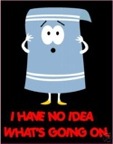| Author
|
confusion about Intervals...need some Music theory advice
|
Kryten
IsraTrance Junior Member

Started Topics :
11
Posts :
333
Posted : Aug 22, 2011 09:30:07
|
Hi again!
I need someone with good music theory knowledge.
Yesetrday I learned some stuff from the Book "Music Theory for Computer musicians".
I think its a very good book, but now and then it really confuses me 
When i came to the chapter about Intervals, everything was fine at first. They were explained and there was a table, showing all Intervals, the modes (maj/min) and the number of semitone steps. In that table, all intervals from 0 semitones from root (first) to 12 semitones from root (octave) were described.
So far so good, nothing confusing here....yet.
A few chapters later though, other intervals were introduced: diminished and augmented.
According to the description, these are build by increasing or descreasing certain intervals by one semitone.
Nowe thats what i really dont get.
For example:
According to the table a few chapters earlier, when I increase a major second interval by one semitone, I have a minor third then...and not an augmented or diminished one.
I dont know if that example makes sense, and I am pretty sure I dont really need to know this for my production skills yet...but I want to work though this book and some day I want to understand everything in there.
So can someone please explain this to me? 
It would be great to udnerstand this finally, as I did read those chapters again and again but was not able to understand why this is like that.
Big thanks in advance!
Cheers,
Kryten
        My first track: My first track:
http://soundcloud.com/kryten/ |

|
|
Dv2
Started Topics :
2
Posts :
27
Posted : Aug 22, 2011 17:15
|
Hi Kryten,
I don't understand it completely myself, but in music theory, you'll often find different names for the same thing. A C sharp, for example can also be called a B flat, it's all just perspective.
A minor third is indeed the same as an augmented second. The difference is only in the name and the staff position (meaning that in notation, a B flat is written differently than a C sharp, although they are the same note. )
Taken from wikipedia:
For instance, the interval from D to F sharp is a major third, while that from D to G flat is a diminished fourth, although they have identical width in equal temperament (4 semitones, or 400 cents).
So, F sharp and G flat are really the same note. But if you choose to call it F sharp, you'd get a major third when counting from D. If you call this note G flat instead, the same interval would be called a diminished fourth.
Wikipedia:
For example, as shown in the table below, there are four semitones between A and C sharp, between A and D flat, between A sharp and D, and between A flat and B sharp, but
the interval A-C sharp is called a major third (as it spans 3 staff positions),
the intervals A-D flat and A sharp-D are called diminished fourths (as they span 4 staff positions),
the interval A flat-B sharp is called a doubly augmented second (as it spans 2 staff positions).
So, in essence, how to NAME an interval is dependent on the number of staff positions it encompasses. But the name doesn't change the number of semitones between intervals. I suggest reading the wikipedia article about intervals, it is really good. But for practical purposes, it is most important to just understand the diatonic interval system 
Hope I could clear it up a little..
|

|
|
Kryten
IsraTrance Junior Member

Started Topics :
11
Posts :
333
Posted : Aug 22, 2011 17:46
|
Hey great, thanks.
That was one of my thoughts, because I already did not understand why tehre are double sharps or flats...still makes no sense to me, but now I know that there is no deeper meaning 
Thanks a lot!
        My first track: My first track:
http://soundcloud.com/kryten/ |

|
|
loki
IsraTrance Junior Member

Started Topics :
49
Posts :
429
Posted : Aug 22, 2011 17:57
|
Quote:
|
On 2011-08-22 17:15, Dv2 wrote:
Hi Kryten,
But for practical purposes, it is most important to just understand the diatonic interval system 
|
|
+1. It's just about learning the language! You got it down, just not the naming conventions yet! But they do help with how to think about the intervals; as in, what they "mean" or the tension they evoke in the context of your chord progression/melody.
        Dance, even if you have nowhere to do it but your living room. ~Kurt Vonnegut Dance, even if you have nowhere to do it but your living room. ~Kurt Vonnegut
www.soundcloud.com/mixyott |

|
|
Kryten
IsraTrance Junior Member

Started Topics :
11
Posts :
333
Posted : Aug 22, 2011 21:33
|
Thanks Loki for an insight why there are these double named things 
The intervals in teh book are 12, so they are the chromatic intervals. I think thats enough, no need for any more now 
        My first track: My first track:
http://soundcloud.com/kryten/ |

|
|
hearttricks
Started Topics :
0
Posts :
87
Posted : Aug 23, 2011 05:42
|
the western music system is an old one... and one that people always seem to want to revise.. so yes, there are many ways to describe the same thing...
words are an imperfect description of music, though, and no notation matters as much as your mind's understanding of how it fits together. |

|
|
moondoggy

Started Topics :
8
Posts :
175
Posted : Aug 23, 2011 06:50
|
|
+111 |

|
|
|